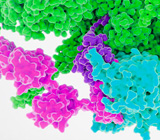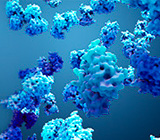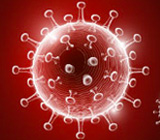-
REAGENT SERVICES
Hot!
-
Most Popular Services
-
Molecular Biology
-
Recombinant Antibody/Protein
-
Reagent Antibody
-
CRISPR Gene Editing
-
DNA Mutant Library
-
IVT RNA and LNP Formulations
-
Oligo Synthesis
-
Peptides
-
Cell Engineering
-
- CRISPR/Cas9 sgRNA
- CRISPR/Cas12a crRNA
- Prime Editing Guide RNA
- Base Editing Guide RNA
- HDR Templates
- gRNA + HDR Template Design Tools
- cGMP Guide RNA
- cGMP HDR Templates
- CRISPR/Cas Proteins
- CAR-T Knock-in Optimization Kit
- CRISPR Plasmids
- CRISPR gRNA Plasmid Libraries
- CRISPR Cell Lines
- Microbial Genome Editing
-
-
PRODUCTS
-
Most Popular Reagents
-
 Instruments
Instruments
-
Antibodies
-
ELISA Kits
-
Protein Electrophoresis and Blotting
-
Protein and Antibody Purification
-
Recombinant Proteins
-
Molecular Biology
-
Stable Cell Lines
-
Cell Isolation and Activation
-
 IVD Raw Materials
IVD Raw Materials
-
 Therapy Applications
Therapy Applications
-
Resources
-
- Pharmacokinetics and Immunogenecity ELISA Kits
- Viral Titration QC ELISA Kits
- -- Lentivirus Titer p24 ELISA KitHot!
- -- MuLV Titer p30 ELISA KitNew!
- -- AAV2 and AAVX Titer Capsid ELISA Kits
- Impurity Test ELISA Kits
- -- BSA ELISA Kit, 2G
- -- Cas9 ELISA KitNew!
- -- Protein A ELISA KitNew!
- -- His tagged protein detection & purification
- -- dsRNA ELISA Kit
- -- Endonuclease ELISA Kit
- COVID-19 Detection cPass™ Technology Kits
-
- Automated Maxi-Plasmid PurificationHot!
- Automated Mini-Plasmid PurificationNew!
- PCR Reagents
- S.marcescens Nuclease Benz-Neburase™
- DNA Assembly GenBuilder™
- Cas9 / Cas12a / Cas13a Nucleases
- Base and Prime Editing Nucleases
- GMP Cas9 Nucleases
- CRISPR sgRNA Synthesis
- HDR Knock-in Template
- CRISPR Gene Editing Kits and Antibodies
-
![AmMag™ Quatro Automated Plasmid Purification]() AmMag™ Quatro automated plasmid purification
AmMag™ Quatro automated plasmid purification
-
![Anti-Camelid VHH]() MonoRab™ Anti-VHH Antibodies
MonoRab™ Anti-VHH Antibodies
-
![ELISA Kits]() ELISA Kits
ELISA Kits
-
![Precast Gels]() SurePAGE™ Precast Gels
SurePAGE™ Precast Gels
-
![Quatro ProAb Automated Protein and Antibody Purification System]() AmMag™ Quatro ProAb Automated Protein and Antibody Purification System
AmMag™ Quatro ProAb Automated Protein and Antibody Purification System
-
![Target Proteins]() Target Proteins
Target Proteins
-
![AmMag™ Quatro Automated Plasmid Purification]() AmMag™ Quatro automated plasmid purification
AmMag™ Quatro automated plasmid purification
-
![Stable Cell Lines]() Stable Cell Lines
Stable Cell Lines
-
![Cell Isolation and Activation]() Cell Isolation and Activation
Cell Isolation and Activation
-
 IVD Raw Materials
IVD Raw Materials
-
![Quick
Order]() Quick Order
Quick Order
-
![Quick
Order]() Quick Order
Quick Order
- APPLICATIONS
- RESOURCES
- ABOUT US
- SIGN IN My Account SIGN OUT
- REGISTER

![Amino Acid Code Amino Acid Code]()
Biology Terms Dictionary
This Biology terms dictionary provides query services for biology and biochemistry terms. Please enter the biology or biochemistry terms you want to search.
List by Alphabet: A B C D E F G H I J K L M N O P Q R S T U V W X Y Z
Cell-Free Protein Production
Introduction
Cell-free protein production is an advanced method for synthesizing proteins in vitro, encompassing not only the expression of proteins from genetic templates but also their subsequent processing, folding, and purification for functional uses. This approach eliminates the reliance on living cells, enabling precise control over reaction conditions and offering a streamlined pathway to produce complex, toxic, or difficult-to-express proteins.
While cell-free protein expression focuses on the transcription and translation of a gene to produce a polypeptide, cell-free protein production extends the scope to include downstream processes such as protein purification, functional assessment, and large-scale manufacturing.
Mechanisms of Cell-Free Protein Production
Setup of Cell-Free Reaction Systems
Cell-free protein production begins with the preparation of lysates or synthetic transcription-translation systems:
- E. coli, wheat germ, rabbit reticulocytes, and insect cell lysates are commonly used as sources.
- Synthetic systems may utilize purified ribosomes, tRNAs, and other essential components.
Template Preparation
- DNA templates (plasmid or linear PCR products) containing a strong promoter and optimized coding sequences are introduced.
- RNA templates can also be directly used in translation-only systems.
Optimization of Reaction Conditions
- Energy sources, co-factors, and stabilizers are added to sustain protein synthesis.
- Additives such as molecular chaperones are included to promote proper folding.
- Modular components allow for incorporation of non-standard amino acids or isotopes for specialized protein products.
Protein Folding and Post-Translational Modifications (PTMs)
- Chaperones and redox-active agents ensure proper folding and disulfide bond formation.
- Systems derived from eukaryotic lysates, such as insect or wheat germ, can perform glycosylation and phosphorylation.
Scale-Up for Production
- Batch and continuous-flow reaction systems allow scaling up to milligram or gram quantities of protein.
- Microfluidic reactors and dialysis-coupled systems maintain reagent balance, enhancing yield.
Protein Purification
- Affinity tags (e.g., His-tag, FLAG-tag) facilitate efficient purification.
- Downstream techniques, such as size-exclusion chromatography or ion-exchange chromatography, ensure protein purity and functionality.
Applications of Cell-Free Protein Production
- Therapeutic Protein Manufacturing: Rapid synthesis of biologics such as monoclonal antibodies, cytokines, and vaccines, especially for urgent needs like pandemics.
- Structural Biology and Biophysics: Production of isotopically labeled proteins for NMR spectroscopy and crystallography studies.
- Functional Proteins for Research: Enzymes, transcription factors, and signaling proteins for biochemical assays and high-throughput screening.
- Synthetic Biology: Customizable systems enable on-demand production of engineered proteins or synthetic pathways for biosensor development and metabolic engineering.
- Diagnostics: High-yield production of antigens for ELISA, lateral flow assays, and other diagnostic tools.
- Production of Proteins with Non-Canonical Amino Acids: Cell-free systems uniquely accommodate incorporation of unnatural amino acids, expanding protein functionality.
Advantages of Cell-Free Protein Production
- Efficiency and Speed: Eliminates time-consuming cell culture steps, enabling protein production within hours.
- Production of Complex or Toxic Proteins: Toxic or aggregation-prone proteins can be synthesized without adverse effects on cell viability.
- Customizable Conditions: Fine control over reaction components allows optimization for protein yield, folding, and activity.
- Scalability and Versatility: Reaction systems are adaptable to small-scale lab use or large-scale production for industrial purposes.
- Expanded Protein Chemistry: Cell-free systems permit the incorporation of non-standard amino acids and isotopes, facilitating advanced applications.
Challenges and Limitations
- High Costs: Reagents such as purified lysates and energy substrates can be expensive compared to traditional cell-based systems.
- Limited PTMs in Certain Systems: Prokaryotic lysates lack machinery for complex eukaryotic modifications like glycosylation.
- Optimization Requirements: Each target protein may require extensive optimization of reaction conditions, including chaperones and folding agents.
- Yield Constraints: Achieving gram-scale production remains challenging for some systems.
GenScript Services and Products for Cell-Free Protein Production
- Custom Protein Synthesis: GenScript offers tailored cell-free protein production services to meet research and industrial needs.
- Protein Purification and Characterization: Comprehensive downstream services ensure the production of high-quality, functional proteins.
Conclusion
Cell-free protein production represents a transformative technology in molecular biology and biomanufacturing by offering unparalleled speed, flexibility, and precision. Its ability to produce complex proteins, incorporate non-standard amino acids seamlessly, and operate without cellular constraints makes it invaluable for research, therapeutic development, and industrial applications. Continued advancements in lysate preparation, energy regeneration systems, and cost-effectiveness are expected to further expand its adoption across various fields.
- Tags:
- Protein
Related Biology Tools
-
GenSmart™ Codon Optimization
GenSmart Optimization is a free online tool for performing codon optimization to improve gene expression. GenScript's patented algorithms are integrated into the tool to optimize the computing capability of high-performance sequence generation.
-
DNA Construct Design Tool
GenSmart™ Design is a free online DNA construct design tool developed by GenScript. GenSmart™ Design has two design modules, the Create Construct module for individual plasmid design and the Create Library module for DNA library design.
-
Codon Frequency Tables
This online tool shows commonly used genetic codon frequency table in expression host organisms including Escherichia coli and other common host organisms.
Service and Products

Protein Expression
GenScript recombinant protein and rAb services provide high quality recombinant proteins and rAbs for a variety of downstream research applications.

Bacterial Expression
One-stop service from Sequence to Protein starting from $1600, 4 weeks.

Insect Expression
GenScript's BacuVance baculovirus expression system was developed by our in-house team of scientists for virus production and expression of recombinant proteins from baculovirus-infected insect cells.

Mammalian Transient Expression
Proprietary High Density (HD) expression system, enhance the protein yield up to 100 fold, achieve antibody titers up to 3 g/L.

Reagents for COVID-19 Research
Gram level, ready to ship RBD proteins, ACE2 assay cell lines and pseudovirus.
-
Top Search
-
Hot Glossary
-
Antibody
If you know of any terms that have been omitted from this glossary that you feel would be useful to include, please send detail to the Editorial Office at GenScript: website@genscript.com
If your term is adopted, we will send 1,000 EzCoupon points to your GenScript account.
-





































